1 Provenience. At least 14 layers were archaeologically recognized, as well as several horizontal squares. However, as with other sites described in this volume, we could see no major temporal or area differences in the types, treatment, or occurrence of the faunal remains, so we have pooled the various archaeological units. Table A1.1 (site 29) lists the provenience units for the 241 studied pieces of bone.
2 Species. Three-quarters of the 241 pieces we examined (excluding 65 pieces of human remains) belonged to roe deer (74.7%), with goat-sheep making up the remainder except for one fox bone (Table A1.2, site 29). This absolutely high amount of species identification results from the intensive analysis by Ovodov, coupled with the relative completeness of many of the sampled fragments. About 100 additional pieces ofuniden-tifiable long bone fragments were only measured for their maximum length.
3 Skeletal elements. Metapodials (24.9%), non-specific long bones (11.6%), mandibles (11.2%), and scapulae (10.4%) make up more than half of the skeletal elements (Table A1.3, site 23). Since skull fragments are usually quite easy to identify, an absolutely low frequency (skull, 3.3%; maxilla, 2.5%) confirms Ovodov’s view that initial butchering occurred elsewhere. They would have been saved after excavation for identification purposes, whereas the very low occurrence of bones of the trunk (vertebrae, 0.4%; ribs, 4.6%; and pelvis, 2.9%) is due in large part to the post-excavation discarding of vertebrae and ribs.
4 Age. Only 19 (8.6%) ofthe 221 pieces whose age could be determined were identified as sub-adult on the basis of tooth eruption, tooth wear, and epiphysial union (Table A1.4, site 29). Whether this suggests a fall-winter hunting schedule, or possibly some form of aboriginal conservation or culling practice cannot be determined at this time.
5 Completeness. As Table A1.5 (site 29) shows, there is a relatively low frequency of complete bones (7.0%), and high frequencies ofbones with one (45.2%) orno anatomical ends (47.7%). In contrast with another site where similarly sized ungulates were food items (Bolshoi Yakor, late Pleistocene reindeer), the Yelenev Cave bones were much less broken and smashed. More than 90% of the Bolshoi Yakor bones were missing both anatomical ends. This suggests that the Yelenev Cave occupants did not need to be as frugal as their Ice Age counterparts, and reflects the discarding of unidentifiable fragments mentioned previously.
6 Maximumsize. The mean for 340 Yelenev pieces is 6.0 cm, and the range is 1.5cmto
17.5 cm. Compared with the pooled assemblage, the dimensions of the Yelenev assemblage are significantly smaller. Looking at the lengths of whole long bones for roe deer and goat-sheep provided by Vera Gromova (1950: table 27) shows that the upper range limit of Yelenev is generally smaller for both species.
7 Damage form. Table A1.7 (site 29) shows each of the damage types we identified for the 241 pieces. Flakes (21.6%), butts (18.3%), cracked-open pieces (11.6%), and segments (10.8%) make up more than 50% of the total number of types. Given that most of the bones recovered from the cave excavation represent limb bones, we find it somewhat surprising that the frequency of splinters (0.4%) is so low. While major long bones when smashed tend to wind up as flakes, damaged metapodials not infrequently are represented by splinters. On the whole, there is nothing especially distinctive about the
Kinds of damage or the frequencies of each type. We see no sure sign of any particular damage signature that might have resulted fTom specialized local carcass processing practices, economic necessity, special processing tools, or idiosyncratic butchering behaviors.
8 Color. With the exception of one piece that is brown colored, a 6.3 cm long medial rib fragment with end-polishing, all the other 240 pieces (99.6%) are ivory colored (Table A1.8, site 29). The singular brown piece might represent roasting, although at the time of our examination we saw no sure sign of thermal modification in any piece as large as
2.5 cm. However, there were three burned pieces smaller than 2.0 cm. These could easily have burned accidentally in or under the fire hearths. Said another way, none of the Yelenev bone, whole or fragmentary, shows any sure sign of having been cooked, let alone roasted.
9 Preservation. All 241 pieces are in excellent condition - we have characterized each as having an ivory rather than a chalky quality (Table A1.9, site 29). High bone quality correlates strongly with deposition in a limestone cave away from the entrance drip line.
10 Perimortem breakage. All but eight (3.3%) of the 241 pieces exhibit some degree of perimortem breakage (Table A1.10, site 29). All but one of the pieces without perimor-tem breakage is a whole bone. The single exception is a fragment of a sub-adult tibial epiphysis. Recall that whole bones are defined as having both anatomical ends and that there can be minor perimortem damage somewhere on the element, i. e., there are 17 whole bones in this sample. Hence, the processing of this assemblage was extensive, as much as that seen in late Pleistocene Siberian archaeological sites, but the degree of completeness is greater.
11 Postmortem breakage. Only two (0.8%) of the 241 pieces has identifiable postmortem breakage. In both cases, excavation or laboratory processing probably caused the damage (Table A1.11, site 29). Thus, the nearly total absence of postmortem breakage suggests that Yelenev Cave received little or no post-depositional disturbance of an identifiable sort.
12 End-hollowing. Carnivores seem to have played only a small part in the perimortem modification of the Yelenev faunal remains. Only one (0.4%) of the 241 pieces exhibits end-hollowing (Table A1.12, site 29). It is a complete, 15.2 cm long, roe deer sub-adult mandible that also has eight tooth dints and two cut marks. We suspect the end-hollowing was caused by a relatively small carnivore such as a dog, but it is possible that an even smaller fox was responsible.
13 Notching. Another presumed (large) carnivore source of damage is tooth-sized semicircular notching on a fracture plane, although some notching must have resulted from impacts by stone or bone tools. Thirteen (5.4%) pieces exhibit notching (Table A1.13, site 29). Twelve have only one notch; one has two notches. Their occurrence seems random. They were found on a scapula, on five long bone flakes, three cracked-open metapodials, a metapodial flake, a mandible, and on two ulna segments. Because only two of the notched pieces also have tooth dints, and none of the notched pieces have tooth scratches, we are of the opinion that most if not all of the notching resulted from bone processing by humans.
14 Tooth scratches. Four (1.6%) of the 241 pieces exhibit tooth scratches (Table A1.14, site 29). Each piece also has tooth dints. The number of scratches and dints in these four pieces is: two scratches and ten dints; three and six; two and thirteen; and one and four. The co-occurrence of scratches and dints is more strongly associated than is the co-occurrence of notching and dints, or as seen below, the co-occurrence of dints and notching.
15 Dints. Table A1.15 (site 29) shows that there are 19 (7.9%) pieces with tooth dints. The range in dint number per piece is 1-13; the mean is 4.2 for pieces with dints. Only two pieces with dints also have notching. This low association leads us to even more strongly feel that notching in this assemblage is the result of human rather than carnivore activity.
16 Pseudo-cuts. There is a surprisingly large number of pieces with damage that we judged as representing pseudo-cuts. Twenty-five pieces (10.4%) have from one to four pseudo-cuts (Table A1.16, site 29). In this assemblage, with an absolutely low number of tooth scratches, and a relatively low number of tooth dints, it would appear that we have misidentified several stone tool cut marks as being the very similar sorts of pseudo-cut marks first recognized in the Razboinich’ya hyena cave deposits. In fact, only two pieces with pseudo-cuts have associated tooth dints, and none is associated with tooth scratches. Hence, true stone tool cut marks and pseudo-cut marks cannot always be differentiated - at least, we cannot do so. However, several of the pseudo-cuts are very fine and visible only with the aid of a x20 hand lens. They may well be cut marks, but their shallow depth, extreme fineness, and lack of a sharp V-shaped cross-section make them questionable as such.
17 Abrasions. Nine pieces (3.7%) ofthe 241 have abrasions, 2-36 each (Table A1.17, site 29). Given the great amount of perimortem breakage, and the gritty nature of the limestone cave, whose rubble would have served well as anvils and hammer stones, we wonder if perhaps most of the perimortem breakage was done with some sort of smooth bone or antler mallet. Smooth-surfaced pounding tools would not be expected to leave abrasion striations.
18 Polishing. Polishing has been found on the ends and middle of bone fragments, as well as on both areas. On the basis ofthe Razboinich’ya hyena cave findings, mid-section polishing is much more common in carnivore bone accumulations than in those deposited by humans. Yelenev Cave is no exception. Only six pieces (2.5%) have polishing solely in the middle, although 89 (37.1%) have polishing on one or both ends and in the middle of these fragments (Table A1.18, site 29). Perhaps most importantly, 71 fragments (29.6%) have no identifiable polishing. This suggests that the occurrence of polishing all over a fragment is not due solely to abrasive actions by or within the midden itself, otherwise there should be no specimens without polishing. One splinter-shaped meta-podial butt had its pointed end polished for at least 4.0 cm, suggesting that it had been used as an expedient tool, perhaps in an awl-like function.
19 Embedded fragments. Fragments still adhering to a blunt impact area or at a notch are defined as being embedded. Twenty-five pieces (10.4%) of the 241 have 1-8 embedded fragments (Table A1.19, site 29). Embedding occurs most often at locations where the cortex is thin and is underlain by abundant spongy bone - for example, the proximal head of the humerus. In the case of human bone, embedded fragments are a useful indication of processing by other humans that involved smashing and pounding. An obvious exception is when embedded fragments occur in what is undoubtedly the tooth penetration area of a large carnivore. Although five (20.0%) pieces with embedded fragments also had tooth dints or scratches, none occurred in a tooth dint. Unquestionable cases of embedding associated with human processing include one set of three embedded fragments in a chop mark, one embedded fragment in another chop mark, and three sets of 2-4 embedded fragments in impact notches. Thus, most if not all of the fragment embedding in the Yelenev sample is attributable to human butchering activity.
20 Tooth wear. Twenty-one pieces (8.7%) of the 241 were tooth-bearing fragments of mandibles or maxillae (Table A1.20, site 29). Wear in all instances except one ranged fTom “present but dentine not exposed” to “dentine exposed but cusps still present.” These would represent mainly sub-adults to younger adults. The exception was a roe deer adult maxilla fTom Square 9-GB, Level 2, where the degree of crown loss was between that where cusps are almost worn off and the pulp chamber is exposed. In deer of normal dental development this is presumably an old adult. There is nothing else distinctive about this specimen. Three individuals with teeth and associated occlusal wear possessed deciduous teeth. These specimens were classified as sub-adults. The presence of worn deciduous teeth suggests several postnatal and weaned months of life. Hence, these animals could have been fall kills, assuming normal seasonal birthing time for this species.
21 Acid erosion. Elsewhere, in hyena caves such as Razboinich’ya, there are numerous bone fragments evidencing the destructive surface modification of their having passed through the stomach and gut of hyenas or other large carnivores, or regurgitated before reaching the intestinal tract. Only one (0.4%) of the 241 Yelenev Cave pieces evidenced such erosion (Table A1.21, site 29). This is a complete 2.9 cm diameter adult roe deer astragalus from Layer 9A. There are four other fragments, each with one remaining anatomical end, that are highly polished but not eroded. These are a 4.4 cm adult calcaneus, a 3.3 cm adult toe, a
1.6 cm adult mandible fragment, and a 2.1 cm adult toe. The two undersized specimens were fully entered into the database because of their exceptional polishing, which might represent some form of carnivore chewing or digestion. Even with the four exceptional specimens, the very low frequency of stomach-acid-damaged bone seems convincing evidence that large carnivores were not normal occupants of Yelenev Cave.
22-23 Rodent gnawing and insect damage. There are no cases of identifiable rodent gnawing or insect damage in our study sample, nor did Ovodov see any sign of gnawing in the many other pieces that were not studied herein.
24 Human bone. Yelenev Cave produced 65 pieces of human bone, representing the very fragmentary and incomplete remains of five individuals, three adults and two sub-adults (Figs. 3.206-3.212). The possibility of cannibalism was evaluated, but no
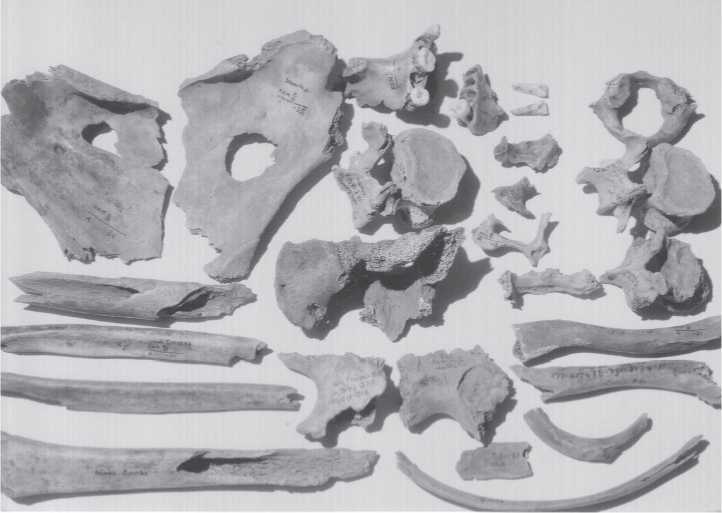
Fig. 3.206 Yelenev Cave, early Neolithic human remains. Shown are the pieces of skeletal elements that are thought to have possibly belonged to a young adult female - light to moderate tooth wear, no pathology, gracility of bone size and muscle markings, and wide sciatic notch. There is chewing damage and polishing. The cause of the holes in the scapulae is unknown. The humerus in the lower left is 19.5 cm in length (CGT neg. IAE 7-23-98:3).
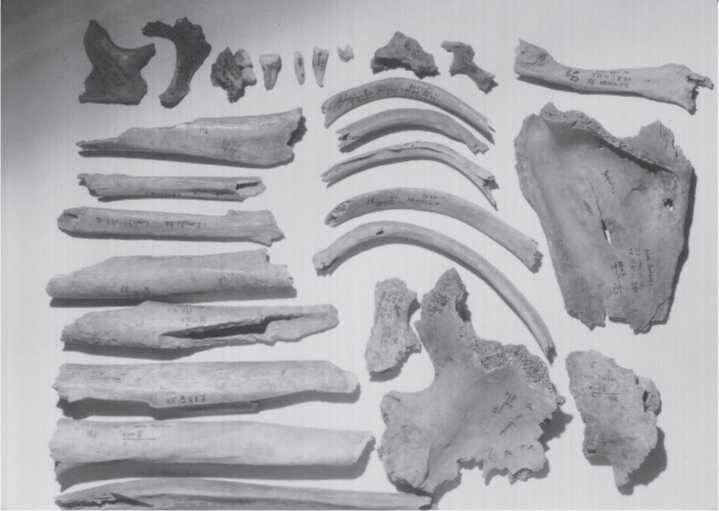
Fig. 3.207 Yelenev Cave, early Neolithic human remains. These bones seem to belong to a middle-aged
Adult female. There is chewing damage. The ulna fragment in the lower left is 21.0 cm in length (CGT neg. IAE 7-23-98:23).
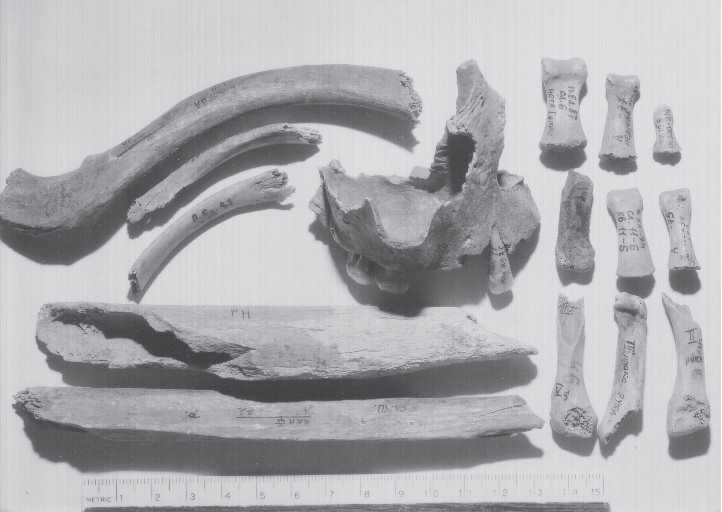
Fig. 3.208 Yelenev Cave, early Neolithic human remains. This set of bones seems to represent another middle-aged adult, but whose sex cannot be even estimated. Scale is 15 cm (CGT neg.
IAE 7-23-98:28).
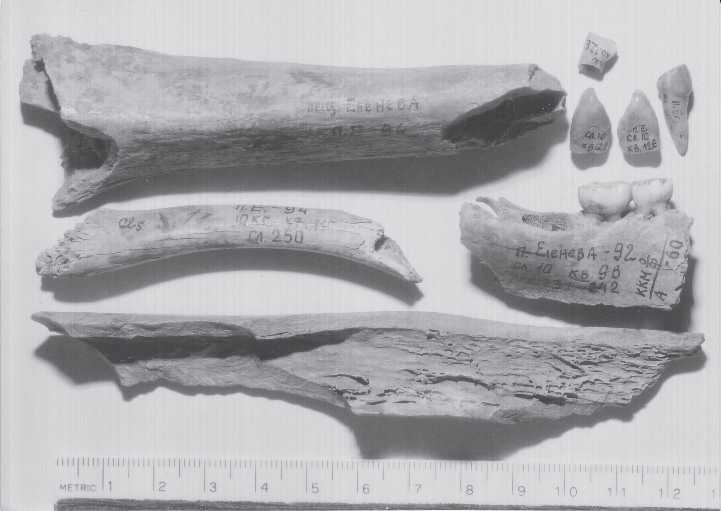
Fig. 3.209 Yelenev Cave, early Neolithic human remains. Mandible fragment and teeth are those of a
5-6-year-old child. The long bone fragments could not be matched with any individual in this assemblage, and the curved long bone piece in the middle may not be human. Scale is in centimeters (CGT neg. IAE 7-23-98:34).
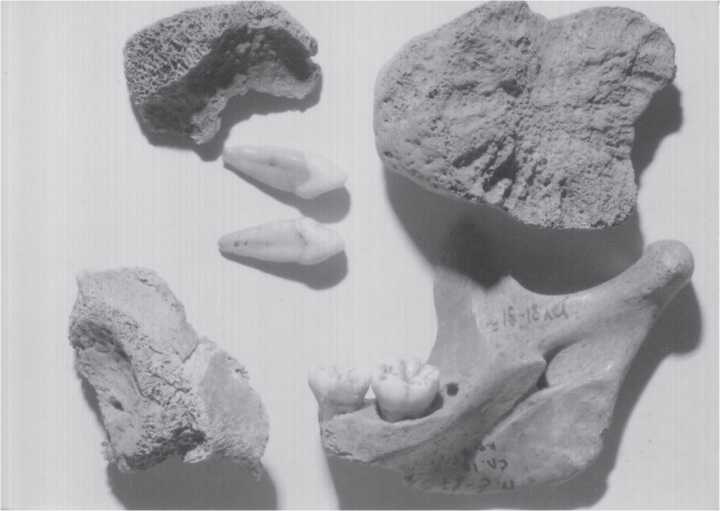
Fig. 3.210 Yelenev Cave, early Neolithic human remains. The pieces probably belonged to one individual, a 12-15-year-old sub-adult (CGT neg. IAE 7-23-98:29).
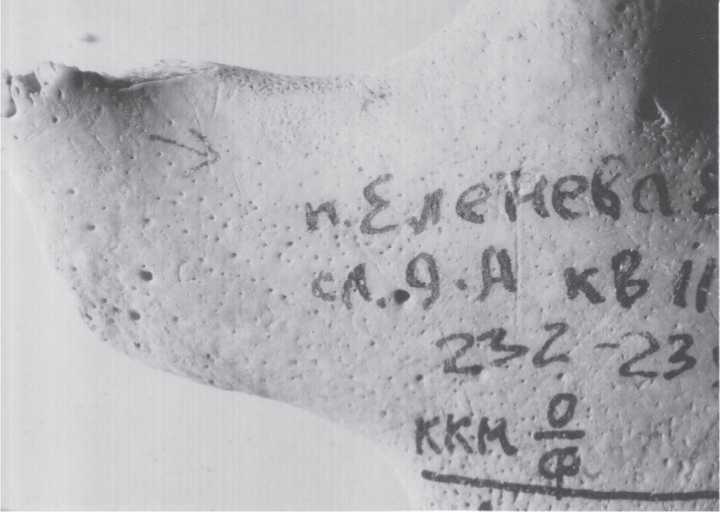
Fig. 3.211 Yelenev Cave, early Neolithic human remains. Cut marks on a zygomatic bone. This
Piece is shown also in the upper left corner of Fig. 3.207. Width of image is 3.6 cm (CGT neg. IAE 7-23-98:21).
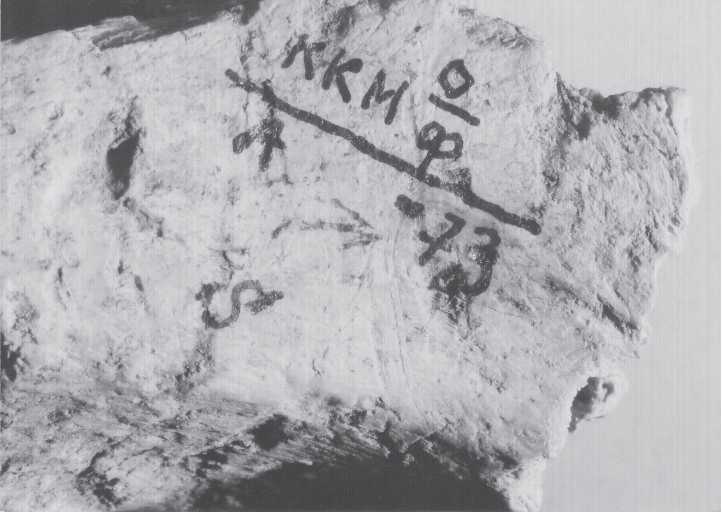
Fig. 3.212 Yelenev Cave, early Neolithic human remains. Abrasions on pelvis near sciatic notch. Actual width of image is 3.3 cm (CGT neg. IAE 7-23-98:6).
Definite conclusion could be reached due to the extensive carnivore damage (78.8% of all pieces had tooth scratches, dints, and extensive polishing). Nevertheless, these human remains come closest to being considered as cannibalized as any human remains the senior author has studied in Russia since 1984. On the basis of very limited dental morphological information, the Yelenev people seemed to have been about equally related to Northeast Asians and Europeans, as has been noted for other Neolithic Siberians. The results of the human perimortem analysis and epigenetic affinity assessment are reported in Turner et al. (2001b).
25 Cut marks. Bones with cut marks are relatively common (17.8%) in Yelenev Cave. Of the total, cut pieces most often have only one incision, although a few have more (Table A1.25, site 29). Cuts seem to occur mostly at joints and muscle and ligament attachment sites, or at random. As discussed above regarding pseudo-cuts, it is likely that the actual number of cuts in this assemblage is greater than 17.8%, which should be viewed as a minimal estimate.
26 Chop marks. Chopping occurs less frequently than cutting. Only 9.1% of the Yelenev assemblage have chop marks, ranging from one to four per piece. One chop mark is the most frequent number (Table A1.26, site 29). There are two examples of chop marks occurring on fractures, which suggests stone tools were used to break these bones. Six chop marks have tiny adhering bone fragments.




 World History
World History









